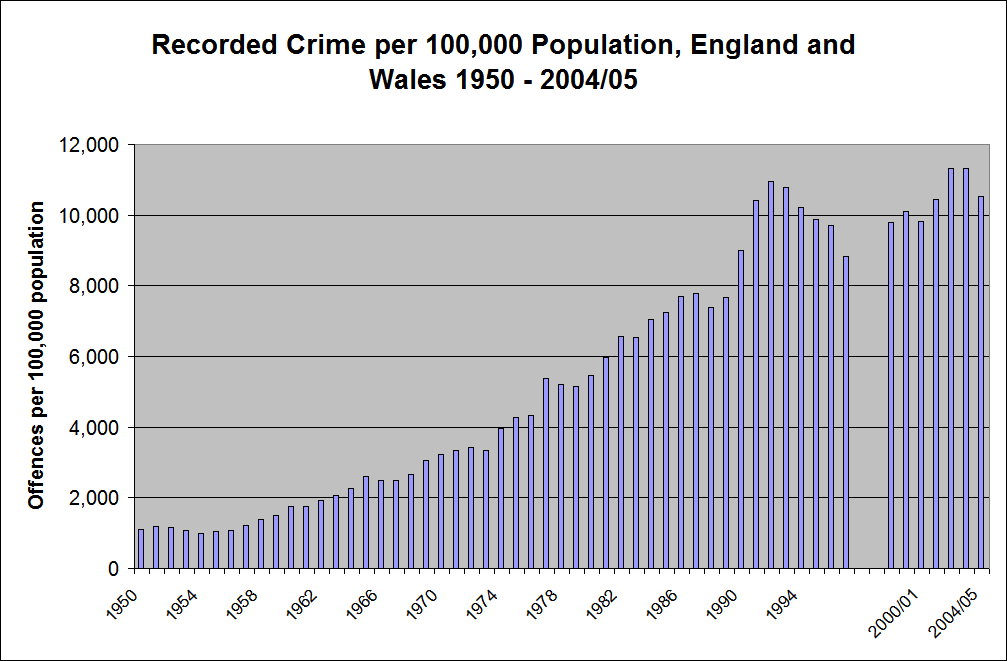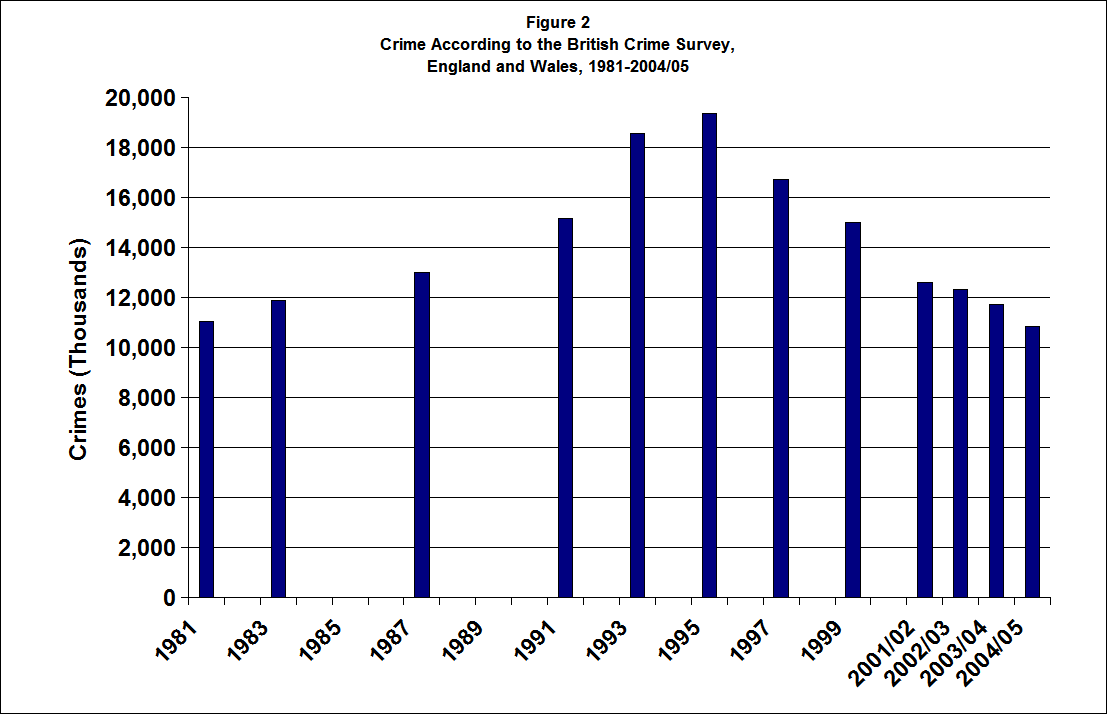Background Briefing: Crime Policy
HOW MUCH CRIME?
How much crime do we suffer today compared with other countries and with our own history?
How much compared with our own history?
The number of recorded crimes per 100,000 population in 1950 was 1,053 and in 1960 still only 1,610. By 1992 the figure reached 10,943. The latest figure for 2004/05 is 10,537, well over ten times the rate in the 1950s.[1]
Crime according to police records

Crime according to the British Crime Survey
The British Crime Survey began in 1981.

How much compared with other countries?
According to the International Crime Victim Survey:
- People in England and Wales experienced more crime per head than any other country in the survey, 54.5 crimes per 100 inhabitants compared with an average of 35.2 per 100.
- People in England and Wales face the second highest risk of being a victim of crime. Australia was the worst with 30% of its people victims of crime in 2000, followed by England and Wales with 26.4%.
- England and Wales had the worst record for ‘very serious’ offences, scoring 18 for every hundred inhabitants, followed by Australia with 16.
- More people have gone to the expense of installing burglar alarms than in any other country surveyed, 34% compared with 26% in Australia and 24% in America.
- People in England and Wales felt they were more unsafe when out alone after dark than people in most other countries surveyed, ranking 4th out of 17.
- Contact crime, defined as robbery, sexual assault, and assault with force, was second highest in England and Wales (3.6% of those surveyed). The highest figure was for Australia, where it was 4.1%. The figure for the USA was 1.9% and for Japan, 0.4%.
Click here for more details of the International Crime Victim Survey.
IS CRIME TODAY GOING UP OR DOWN?
This ought to be a simple question to answer, but it isn’t. In order to make the figures more accurate, the Home Office has recently changed the way the police keep records of crime. The National Crime Recording Standard (NCRS) came into effect for all police areas in April 2002. The British Crime Survey had shown that the police did not record all the crimes reported to them and the NCRS was intended to reduce the extent of under-recording.
The Home Office estimates that overall crime in 2002/03 was 10% higher because of the previous under-counting. Instead of taking the more up-to-date figure as the benchmark, the Home Office deducted estimates of the additional crimes from the latest year to make comparisons with previous years. This allowed the Home Office to claim that crime fell in 2002/03.
However, if the latest figures are considered to be more accurate, it would have been more logical to add an estimate of under-counting to previous years to facilitate comparison. Failure to do so has made it very difficult to establish whether crime in the last year or two has been going up or down. For this reason it is better to look back over a longer period. In any event as the chart above shows, to argue about the increase during the last couple of years is to argue about whether crime has gone up by ten times the rate in the 1950s or by nearly eleven times. The real danger is that the Government has complacently accepted that we have become a permanently high-crime society.
WHY HAS CRIME FALLEN SINCE 1993?
Police records suggest that crime reached a peak in about 1993 and the British Crime Survey that the peak was in 1995. Why has crime fallen since then? The main reason is that more offenders are in prison. To claim that increasing the use of prison reduces crime is controversial. Between 1993 and 2001 the average number of people in prison rose from 45,633 to 66,300, an increase of over 45%.
What happened to crime over this period? According to the BCS crime fell from 19.1 million in 1995 to 12.6 million in 2001/02. Was it just a coincidence?
Even if no deterrent effect is assumed, the incapacitation effect of imprisoning on average another 20,000 criminals would have been substantial. How can we work out the incapacitation effect? The Home Office report, Making Punishments Work, estimated that the average offender carried out 140 offences per year.
We can make a rough calculation of the incapacitation effect of jailing 20,000 full-year equivalent offenders. If each prisoner carried out the average number of offences identified by the Home Office, then 2.8 million offences against the public would have been prevented by 12 months in jail.
Click here for more details.
If Crime Has Fallen Since 1993 Because of Increased Imprisonment of Offenders, Why Is the Government Not Building More Prisons?
What are the Government’s policies?
Government policy reflects two potentially contradictory lines of thought. Many in the Home Office are hostile to prison and want to reduce its use, but their influence has been tempered by acknowledgement that community sentences do not adequately protect the public. This realism has led the Government to the search for ‘tough community sentences’ that, in the words of the white paper Justice For All are a ‘credible alternative to custody’, including community sentences with multiple conditions like tagging, reparation and drug treatment and testing. It is imperative, according to the Government, that ‘we have a correctional system which punishes but also reduces reoffending through the rehabilitation of the offender’. Consequently, it says, a genuine third option is needed in addition to custody and community punishment.
The most important of these third options to be implemented so far is the Intensive Supervision and Surveillance Programme (ISSP) which began in April 2001 with an investment of £45m over three years.
Are the Government’s policies likely to work?
There are two main elements of the new community sentences, summed up by the name of the latest variant, the Intensive Control and Change Programme (ICCP). This scheme is for 18-20 year-olds but similar principles are applied to younger offenders, under the name Intensive Supervision and Surveillance Programme (ISSP).
The ‘control’ element includes curfew or home detention and monitoring by probation officers. How effective have such schemes been in England?
The ‘change’ element includes teaching educational skills, both general and vocational, and providing ‘offending behaviour programmes’ inspired by cognitive behavioural therapy. What we know about the effectiveness of these programmes suggests they are highly imperfect substitutes for prison.
In July 1998 the Home Affairs Select Committee concluded that: ‘The absence of rigorous assessment of the effectiveness of community sentences is astonishing. Without it confidence in them must be limited and sentencing policy a matter of guess-work and optimism’. The independent study of the Intensive Supervision and Surveillance Programme found it to be less effective than ordinary probation at reducing offending. In October 2005 the final report was published and found that 91% of offenders who had taken part in ISSP were reconvicted within the two-year follow up.[2]
Click here for more details.
Why Should We Believe That Prison Works?
From the early 1980s until the mid-1990s the risk of imprisonment increased in the USA and the crime rate fell; while in England and Wales the opposite happened: the risk of imprisonment fell and the crime rate increased. Then, from 1993, policy in England and Wales was reversed and the risk of imprisonment increased, though it remained historically low. Even this relatively small increase in the use of prison was followed by a reduction in crime.
Click here for an account of the evidence from America. (link to existing but not compatible page)
Disentangling cause and effect.
Many of the facts in the crime debate are the subject of intense discussion, with armies of academics sometimes disputing the truth for years at a time. The link between prison and crime is more heated than most. Some academics say that crime causes the rate of imprisonment. Others says that the extent to which known offenders are imprisoned influences the crime rate: if more habitual offenders are put in jail the crime rate will fall. Both views can be defended. There are many influences on crime and the extent to which criminals are incarcerated is only one of them. It is possible that, if all other influences remained unchanged, an increase in the proportion of young men in the population could lead to increases in crime and that, if judges continued to follow the same sentencing policies, the prison population would increase. It is also possible that crime could be so prevalent that the prison system could be overwhelmed.
When comparing the USA with England and Wales, how can we be sure that the size of the prison population was the ‘independent variable’, in the jargon of statisticians? Economist Steven Levitt has suggested a way of settling the dispute. He set out to identify the causal direction of change by studying American states in which the prison population was reduced by court decisions unrelated to the amount of crime, namely those subject to a court order that prisoners must be released to reduce overcrowding.[3]
In 12 states the prison regime had been subject to court orders reducing overcrowding. In these 12 states in the three years before filing of litigation, the prison population outpaced the national average by 2.3% per year. In the three years after filing it lagged behind the national average by 2.5% per annum. And three years after the final court order the growth rate was 4.8% below the national average.[4] Levitt found that in such states reductions in the prison population led to increases of crime, demonstrating that incarceration is the independent variable. On average, a reduction of one prisoner led to 15 Index (serious) crimes per year.
Levitt’s method was to identify a cause of the size of the prison population that was independent of the underlying amount of crime, namely that the courts forced a reduction in the prison population. From time to time radical changes in public policy have a similar independent effect. One such change occurred in England and Wales in 1993. The fall in crime following the 1993 reversal of policy was significant. If the volume of crime is the main cause of the size of the prison population, it is difficult to see why the fall in crime after the mid-1990s would have led to an increase in imprisonment. Critics of the size of the prison population usually claim that it is caused either by vindictive judges or a punitive public, or both.
Click here for a discussion of the impact of the 1993 ‘Prison Works’ policy.
Notes
1. Crime in England and Wales 2004/05, Table 2.05.
2. Gray, Emily et al., Intensive Supervision and Surveillance Programme: the Final Report, London: Youth Justice Board, 2005, p. 9.
3. Levitt, S.D., ‘The effect of prison population size on crime rates: evidence from prison overcrowding litigation’, Quarterly Journal of Economics, May 1996, pp. 319-51.
4. Levitt, p. 323.
